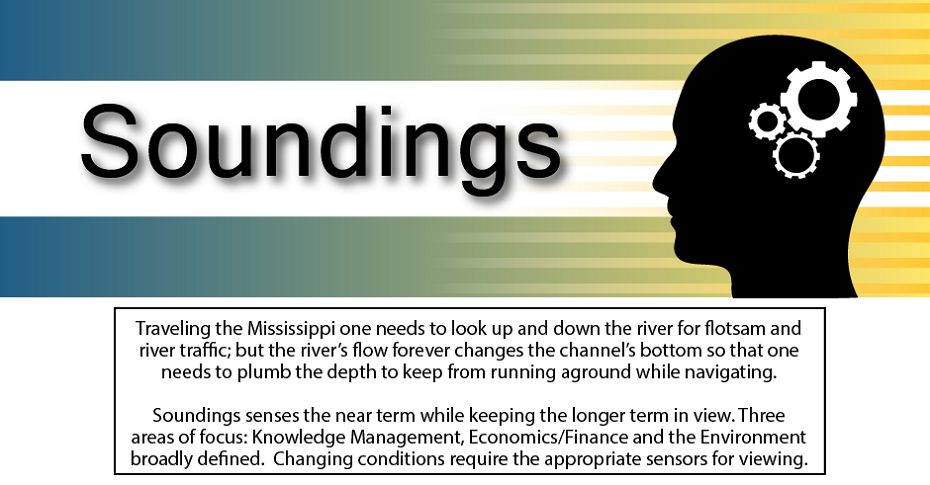SOUNDINGS
Traveling
the Mississippi one needs to look up and down the river for flotsam and river
traffic; but the river’s flow forever changes the channel’s bottom so that one
needs to plumb the depth to keep from running aground while navigating.
Soundings
senses the near term while keeping the longer term in view. Three areas of
focus: Knowledge Management, Economics/Finance and the Environment broadly
defined. Changing conditions require the appropriate sensors for viewing.
We
swim in the river of time. How we perceive our movement becomes critical. For
example, we believe that it was a giant meteor that struck the planet and wiped
out the dinosaurs. Yet the evidence indicates that their demise occurred over
many years post the impact. In other words, the event was not an instantaneous
event, except on paper that graphs the earth’s history. Today we are concerned about “tipping points”,
events that appear to represent a paradigm shift such as the adoption of computers
in schools or the broader digital revolution in its many forms. Other tipping
points have been evoked to talk about collapse from climate change as an
example.
In
2012 Lamberson and Page, in a Santa Fe Institute Working Paper (Tipping Points,
2012-2-002) finally provided a concrete, mathematical, definition that had only
been, up to this point a qualitative, graphic, one-dimensional definition of
“Tipping Points”. The article classified these “events” by type and provided
criteria for careful analysis. One of the immediate results was to point out
that how one represented the information in graphical form could mask or create
such events. More interestingly, the analysis would show that under defined
parameters it could be shown that, like chicken pox, the tipping point occurred
long before its effects became evident. Or, such “events” might happen but they
did not manifest in the dramatic “hockey stick” rise or as a significant
disruption.
The
Gartner Group, which tracks technological change, has created what they call
The Hype Cycle (c.f. the eponymous book by Fenn and Raskino). They basically
have graphically transformed the idea of a tipping point for many technologies
into a curve that tracks the rapid rise, dramatic fall and recovery into a
traditional growth curve. This creates an interesting story but, as mentioned
above, is largely dependent on how these trends are mapped. A similar idea was developed by George Land
in a volume, Grow or Die.
Drawing on Stephen Wolfram’s seminal volume, A
New Kind of Science, Lamberson and Page note that there are tips that change
the system’s behavior and ones that do not. There are political, physical and
economic systems that fall into four classes: fixed point, periodic, random and
complex. What we see depends on the
system’s behavior moving from one class to
another. Most of the simple representations of tipping points stay within a very
simple model. What the Lamberson and Page model does is remove the constraints
that are created by a single vision and a possible misreading of the present
and future and provides a foundation for a sound evaluation. It provides a tool
set that anticipates alternatives rather than proscribing.
